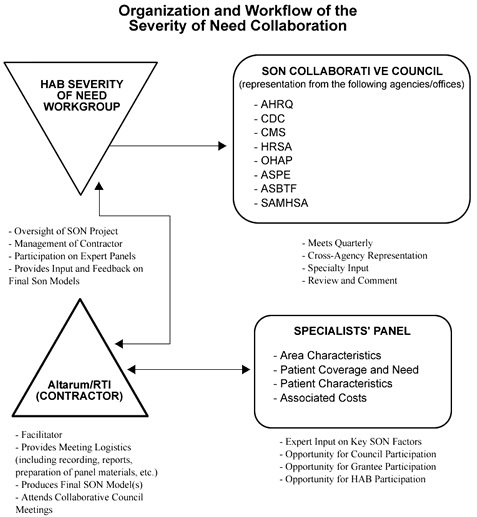PROCESS
SON Collaborative Partners & Framework
Acting upon the IOM findings, HRSA established a SON Collaboration to develop a conceptual model to assess the severity of need for Ryan White programs and services and distribute the funds according to quantifiable measures. The SON Collaboration was formed in 2005 and includes broad membership from Federal, State, local, and community voices. Over a two-year span, over 75 individuals provided input in multiple advisory bodies. The Contractor Team (Altarum/RTI) oversaw the investigation carried out by the four panels, engaging in 100+ conference calls, additional meetings, intense research, and panel reports that were used to develop a draft SON Index. The SON Collaboration is organized as follows (for additional background information, see the Collaborative Framework).
SON Collaborative Council. A Collaborative Council provides input and feedback to the effort and is comprised of eight HHS agencies and offices. Specialty Panels, described below, were in part recommended by its members, who are from:
- Agency for Healthcare Research and Quality (AHRQ)
- Centers for Disease Control and Prevention (CDC)
- Centers for Medicare and Medicaid Services (CMS)
- Health Resources and Services Administration (HRSA)
- Office of HIV/AIDS Policy (OHAP)
- Assistant Secretary for Planning and Evaluation (ASPE)
- Assistant Secretary for Budget, Technology, and Finance (ASBTF)
- Substance Abuse and Mental Health Services Administration (SAMHSA)
HAB SON Workgroup. Composed of representatives from all HAB Divisions, this body provides overall guidance on the SON Index under development and works with the contractor on development of the SON Index.
Specialist Panels. Convened by the Contractor Team, collectively, there were 47 members on the four panels. Members include national experts, staff from across HHS as well as a representative from the Census Bureau, Ryan White Program representatives, and contractor staff (see Panel Membership). Each panel was assigned to investigate and compile information on one of the following quantitative concepts used in the draft SON Index:
- Area Characteristics – structural characteristics of an area that make the care of HIV/AIDS more resource-intensive in one area than another
- Patient Coverage and Need –the medical care available to patients and the level of need that infected patients have for services
- Patient Characteristics – characteristics of infected patients that result in a greater need for resources for some populations than for others
- Associated Costs – regional variation in medical costs that affect the cost of HIV care.
In 2005-2006, the panels completed their investigation of how each element contributes to resource needs and determined appropriate data to measure that element. Panels investigated variables in terms of their strengths and weaknesses (e.g., availability of data, reliability and validity of data). From this, each panel recommended variables to include in the draft SON Index. In turn, panels recommended weighting factors for each measure (or data source) for use in documenting that variable.
Each panel conducted its investigation following a formal process coordinated by a panel chair and a formal voting process. Deliberations were guided by an examination of IOM Committee recommendations and a specific review of variables in terms of their integrity for use in gauging severe need. Their work was completed via 100+ conference calls, meetings, and culminated in panel reports. Each report describes their process for eliminating and recommending inclusion of variables in the SON Index. Their intense work was used to shape the draft SON Index.
Contractor Team: Altarum/RTI. The above process has been coordinated by the contractor team. Their role: facilitate panels, identify experts for the panels, provide logistical support, and develop SON models from panel recommendations. The contractor also analyzed strengths and weaknesses of proposed models and wrote reports detailing methods and findings.
Collaborative Framework:

Image Description:
The SON Collaborative Council provides specialty input directly to the HAB Severity of Need Workgoup on the process, reviews and comments on products, and meets quarterly. It includes representation from the following agencies:
- Agency for Healthcare Research and Quality (AHRQ)
- Centers for Disease Control and Prevention (CDC)
- Centers for Medicare and Medicaid Services (CMS)
- Health Resources and Services Administration (HRSA)
- Office of HIV/AIDS Policy (OHAP)
- Assistant Secretary for Planning and Evaluation (ASPE)
- Assistant Secretary for Budget, Technology, and Finance (ASBTF)
- Substance Abuse and Mental Health Services Administration (SAMHSA)
The HAB Severity of Need Workgroup is composed of representatives from all HAB divisions and manages the work of the Contractor Team. The members update the Collabortive Council regularly and are responsible for:
- Oversight of SON project
- Management of Contractor
- Participation in expert panels
- Providing input and feedback on final SON model(s)
The Contractor Team, Altarum and RTI, contracts with and reports to HAB. The Team manages all activities of the Specialist's Panel and is responsible for the following:
- Facilitating the process
- Providing meeting logistics (including recording, reports, preparation of panel materials, etc.)
- Producing final SON Model(s)
- Attending Collaborative Council Meetings
The Specialists’ Panel provided an opportunity for input from the Collaborative Council, grantees, and HAB. The panelists contract directly with the Contractor team. Four panels were assigned to investigate and compile information on one of the following quantitative concepts used in the draft SON Index:
- Area characteristics
- Patient coverage and need
- Patient characteristics
- Associated costs
|